We all get in our feelings sometimes and when the big sads hit there’s one place I like to dive in until the wave passes – art. Lately I’ve been in a solid soup (solid soup?) of depression and trying to art my way out, but it got me thinking – what are some sad paintings that are already out there? What are they about and can they offer some perspective on what’s solid souping (this is a thing now) around in my sad brain?
So let’s check it out! Here are 10 sad paintings because, well… sad.
Lucretia – Artemisia Gentileschi
Artemisia Gentileschi has to come first – she’s my favorite! Her depictions of powerful women not only starkly contrasted the feeble, meek women painted by her male counterparts – it was layered with themes of trauma, injustice, and resilience.
This painting is a poignant depiction of the legendary Roman heroine’s tragic end. Lucretia, a virtuous noblewoman, has been raped by the son of Tarquin, the tyrannical Etruscan king. This composition shows Lucretia standing at the center. Her body poised in a moment of profound resolve and despair as she prepares to take her own life to preserve her honor. Her expression is one of anguish and determination, reflecting the profound trauma she has endured and the agonizing choice she now faces.
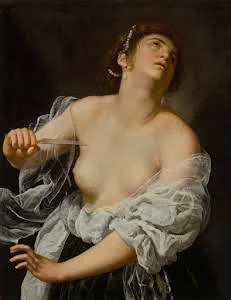
Gentileschi’s portrayal of Lucretia’s suicide is both powerful and empathetic. It captures the emotional intensity of the moment while also conveying the strength and dignity of the heroine. The composition emphasizes Lucretia’s isolation. The dark background and stark lighting focuses on her solitary struggle. Through her skillful rendering of emotion and narrative, Gentileschi invites viewers to reflect on themes of honor, agency, and the enduring resonance of female resilience in the face of injustice.
Christina’s World – Andrew Wyeth
This is one of those paintings that you are all but guaranteed to have seen before. Christina’s World depicts a young woman lying in a field, looking up towards a distant farmhouse. She appears to be crawling or dragging herself through the grass using her arms, as if she is trying to reach the house.
The woman in the painting is Christina Olson, a neighbor of Wyeth who suffered from a degenerative muscular disorder that paralyzed her lower body. Despite her physical limitations, Christina was known for her fierce independence and determination to live her life as fully as possible.
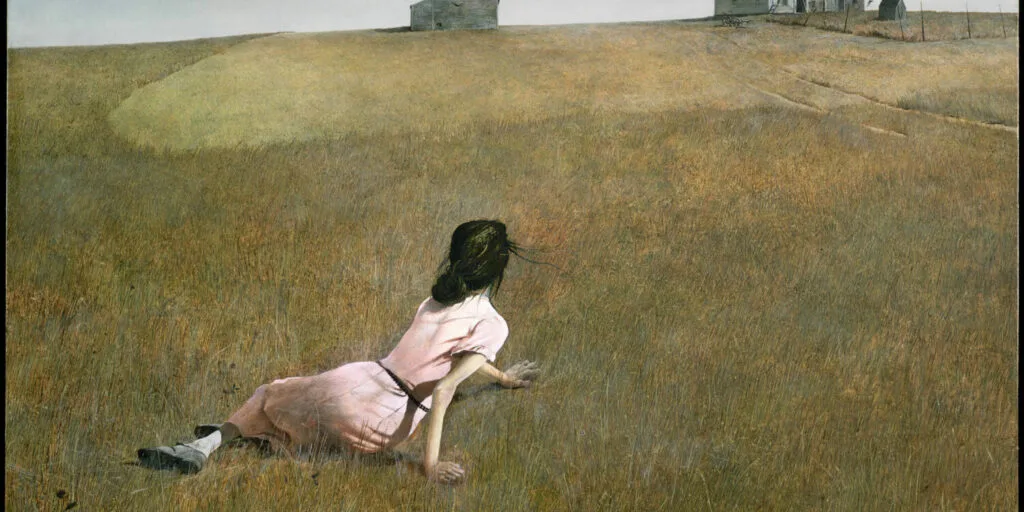
Christina’s World is often interpreted as a portrayal of perseverance in the face of adversity. The vast, empty landscape and the distant farmhouse evoke feelings of isolation and longing. Christina’s determined posture suggests a quiet strength and resilience. The painting has been widely celebrated for its haunting beauty and emotional depth, and it remains one of Wyeth’s most iconic works.
The Death of Marat – Jacques-Louis David
The Death of Marat captures a pivotal moment in the French Revolution. Jean-Paul Marat, a fervent revolutionary leader known for his radical politics and influential writings, is shown in the final moments of his life, slumped over in a bathtub after being assassinated by Charlotte Corday. He holds a piece of paper in his hand, symbolizing his dedication to the revolutionary cause even in death.
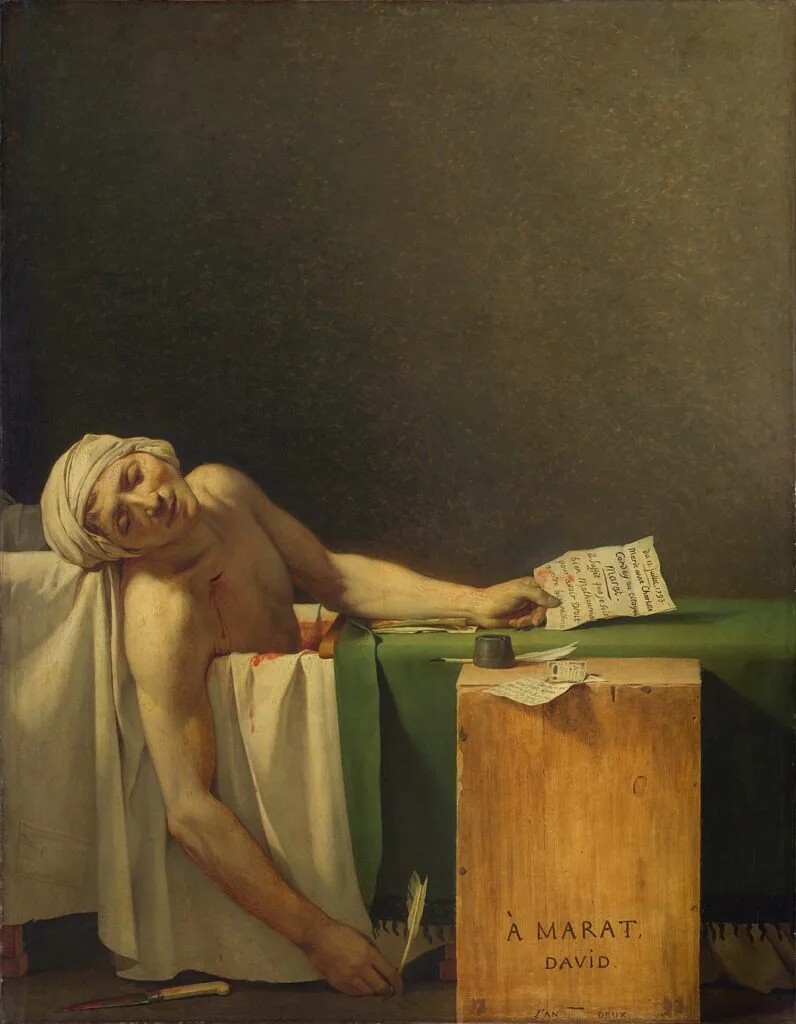
David’s portrayal of Marat is highly idealized, presenting him as a martyr for the revolution. The painting exudes a sense of heroism and sacrifice, with Marat depicted with a serene expression on his face, almost saint-like in his demeanor. Through meticulous attention to detail and dramatic composition, David creates a powerful image that has come to symbolize the revolutionary fervor of the time and the price paid by those who fought for liberty and equality. The Death of Marat is one of the most enduring works of art from the French Revolution, resonating with viewers as a testament to the human cost of political upheaval.
The Dead Mother – Edvard Munch
Munch’s work goes so far beyond The Scream. He goes deeper, darker, and sadder in works like The Dead Mother. It’s a haunting painting that delves into themes of grief, loss, and the fragility of life. Munch portrays a deeply emotional scene where a young girl, presumably his sister, is kneeling beside the bed of her deceased mother. The mother’s body is shrouded in white sheets, her face obscured, as she lies motionless. The girl’s posture and expression convey a profound sense of sorrow and mourning.
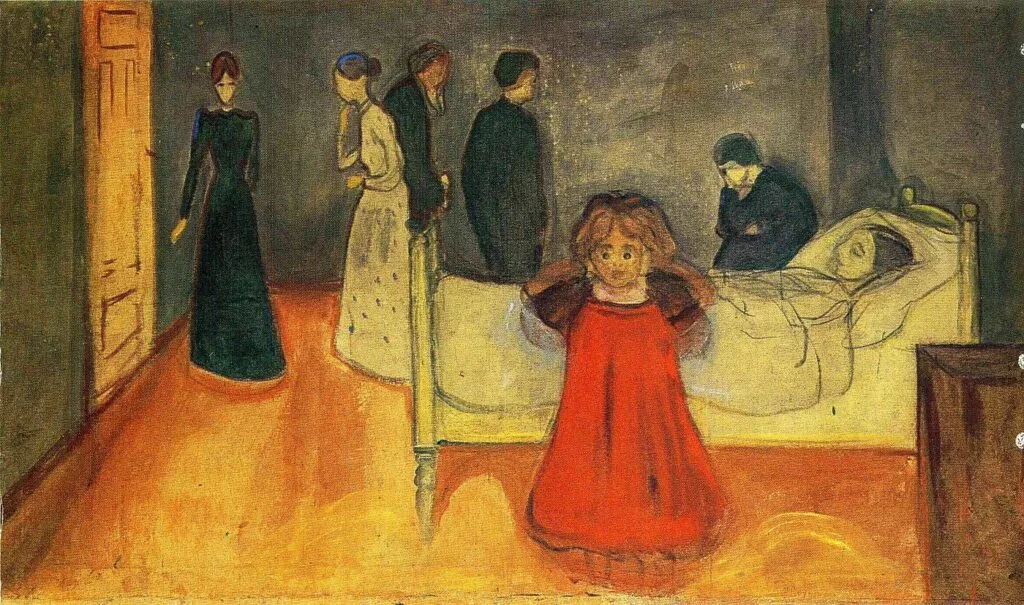
Munch’s use of color and composition adds to the poignancy of the scene, with muted tones and soft, flowing lines contributing to the overall sense of melancholy. The sparse surroundings and the starkness of the room heighten the feeling of isolation and emptiness, emphasizing the profound loss experienced by the girl. Through The Dead Mother, Munch explores the universal experience of losing a loved one and the complex emotions that accompany such a profound loss. This piece invites viewers to contemplate the fleeting nature of life and the inevitability of death.
The Death of Sardanapalus – Eugène Delacroix
The Death of Sardanapalus is a dramatic and emotive painting, inspired by Lord Byron’s play Sardanapalus. Set in ancient Assyria, it depicts the final moments of the decadent and ruthless king, Sardanapalus, who orders the destruction of his palace, possessions, and harem in a fiery inferno upon learning of his imminent defeat in battle. The composition is chaotic and frenzied, with figures in various states of agony, despair, and ecstasy as they meet their fates. The central figure of Sardanapalus reclines on a sumptuous bed, surrounded by opulence and excess, embodying his defiance in the face of defeat and impending death.

Delacroix’s painting is a vivid representation of the themes of power, excess, and the inevitability of mortality. It captures the brutality and hedonism of Sardanapalus’s rule, as well as the tragic consequences of his hubris and decadence. The vibrant colors, dynamic composition, and expressive brushwork contribute to the intense emotional impact of the scene, inviting viewers to contemplate the fleeting nature of power and the consequences of unchecked ambition. Through this powerful imagery, Delacroix invites reflection on the human condition and the destructive impulses that can accompany the pursuit of power and pleasure.
The Poor Poet – Carl Spitzweg
The Poor Poet is a whimsical portrayal of the struggles and aspirations of the romanticized figure of the artist. Set within the cozy confines of a small attic room, the painting depicts a disheveled poet absorbed in his creative pursuits amidst humble surroundings. He is surrounded by books, papers, and a makeshift bed, suggesting a life of simplicity and modest means. Despite his poverty, there is a sense of contentment and dedication in his demeanor as he diligently works on his craft, undeterred by external hardships.
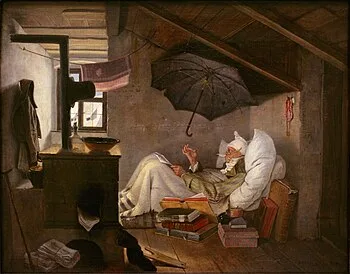
Spitzweg’s painting captures the romantic idealization of the artist as a solitary figure devoted to his creative vision, detached from the material concerns of the world. The attic space serves as a sanctuary for the poet, a refuge where he can immerse himself in his thoughts and imagination. Through his portrayal of the poor poet, Spitzweg celebrates the resilience and passion of artistic endeavor, emphasizing the intrinsic value of creativity and expression in the face of adversity. The painting invites viewers to reflect on the enduring allure of artistic pursuits and the capacity of the human spirit to find joy and fulfillment through creative expression, regardless of external circumstances.
L’Absinthe (Dans un Café) – Edgar Degas
This haunting portrayal shows the darker side of urban life in late 19th-century Paris. Set in a dimly lit café, the painting features a solitary figure, hunched over a table with a glass of absinthe in hand. The man’s vacant stare and slumped posture convey a sense of desolation and despair, suggesting a life marked by disillusionment and inner turmoil. Surrounding him are elements of urban decay and neglect, such as the worn-out furniture and peeling paint, further emphasizing the bleakness of his surroundings.
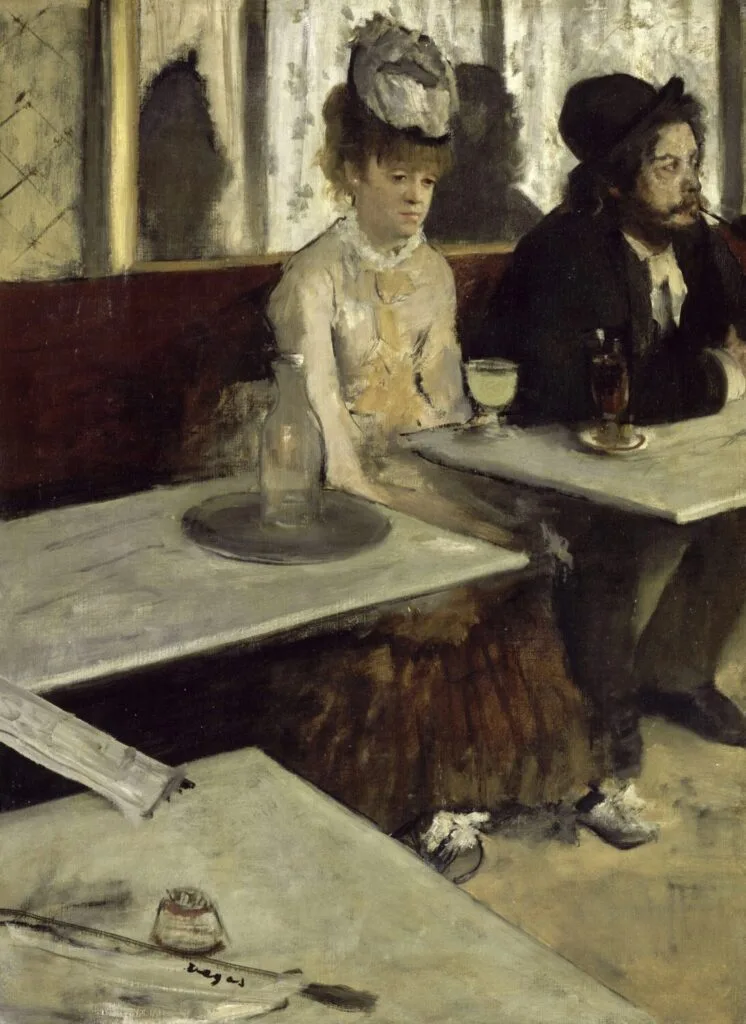
Degas’s painting captures the pervasive sense of alienation and ennui experienced by many individuals living on the margins of society during this period. The absinthe serves as a symbol of escapism and self-destructive behavior, reflecting the man’s attempt to numb his pain and evade the harsh realities of his existence. Through his sensitive portrayal of the absinthe drinker, Degas invites viewers to confront the social and psychological implications of addiction and urban isolation, highlighting the profound impact of modernization and industrialization on the human condition. Ultimately, the painting serves as a poignant reminder of the fragility of the human spirit and the precariousness of life in the modern city.
Sorrow (The Magdalen) – Paul Cezanne
It doesn’t take a second look to know this is just a sad painting. Sorrow, also known as The Magdalen, shows a woman in a state of deep emotional anguish. The painting features Mary Magdalene, a figure from the bible associated with repentance and redemption. Cezanne’s interpretation diverges from traditional religious representations, focusing instead on the intense psychological and emotional depth of the subject. The woman’s downturned gaze and pained expression convey a sense of inner turmoil and sorrow, inviting viewers to empathize with her emotional state.
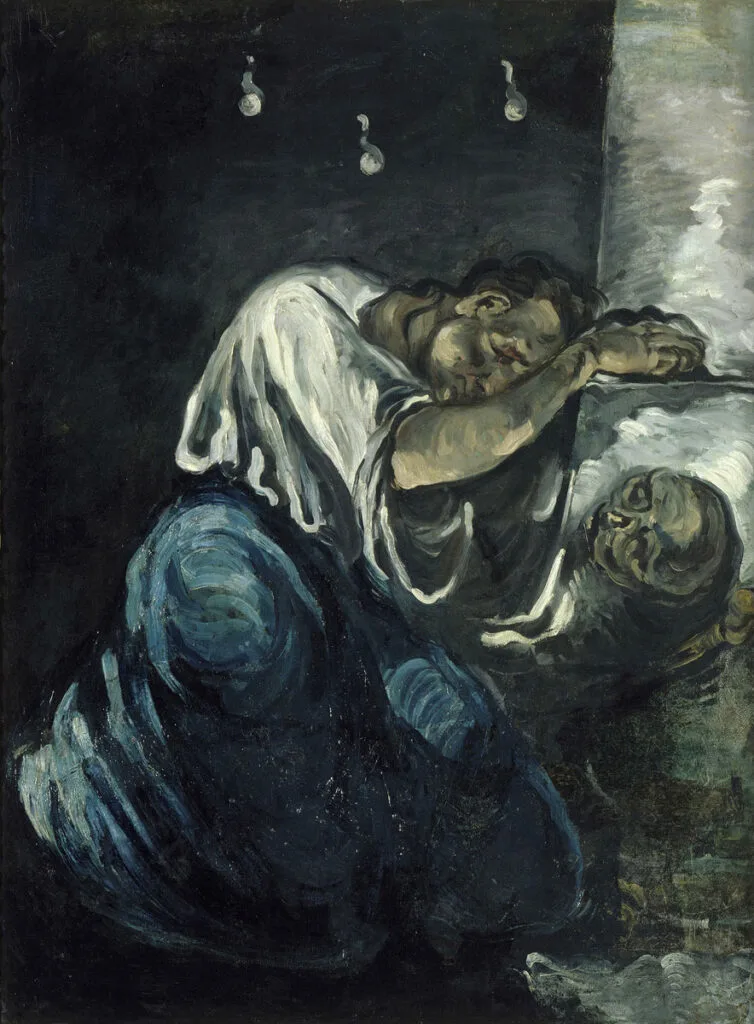
Cezanne’s use of color and brushwork further enhances the emotional resonance of the painting. The subdued palette and subtle variations in tone contribute to the somber mood, while the expressive, gestural brushstrokes imbue the composition with a sense of raw emotion and immediacy. The sparse background and minimalistic composition draw attention to the central figure, intensifying the viewer’s engagement with the woman’s emotional journey.
Sorrow exemplifies Cezanne’s innovative approach to figurative painting, which prioritizes the exploration of psychological depth and emotional resonance over traditional narrative or religious symbolism. Through his sensitive portrayal of the Magdalen’s sorrow, Cezanne invites viewers to contemplate universal themes of suffering, redemption, and the human capacity for resilience in the face of adversity.
The End of the World (The Great Day of his Wrath) – John Martin
The End of the World is a dramatic and apocalyptic vision of the destruction of civilization. Martin’s work captures the romantic fascination with cataclysmic events and the sublime power of nature. The painting depicts a tumultuous scene of chaos and devastation, with towering waves engulfing cities and mountains crumbling into the abyss. In the foreground, figures are depicted in various states of despair and awe as they witness the unfolding catastrophe.
Martin’s use of light and shadow heightens the sense of drama and awe, casting the scene in an eerie, otherworldly glow. The sweeping, dynamic composition draws the viewer’s eye across the canvas, conveying a sense of movement and energy as the world is consumed by elemental forces. The End of the World serves as a powerful allegory for the fragility of human civilization in the face of natural disasters and the inexorable passage of time.

Through his monumental and visionary painting, Martin invites viewers to contemplate the grandeur and terror of nature, as well as the transient nature of human existence. The End of the World stands as a testament to the enduring power of art to evoke emotion, provoke thought, and confront the mysteries of existence.
St. Jerome In His Study By Candlelight – Aertsen Van Leyden
St. Jerome in His Study by Candlelight is a captivating portrayal of the revered Christian scholar and theologian, St. Jerome, immersed in his scholarly pursuits. The painting depicts St. Jerome seated at a desk in his study, illuminated by the warm glow of a candle. He is engaged in deep contemplation, surrounded by books, papers, and various scholarly instruments, indicating his dedication to intellectual pursuits and spiritual reflection. The scene exudes a sense of serenity and introspection, inviting viewers to enter the intimate space of the saint’s study and share in his quiet devotion.
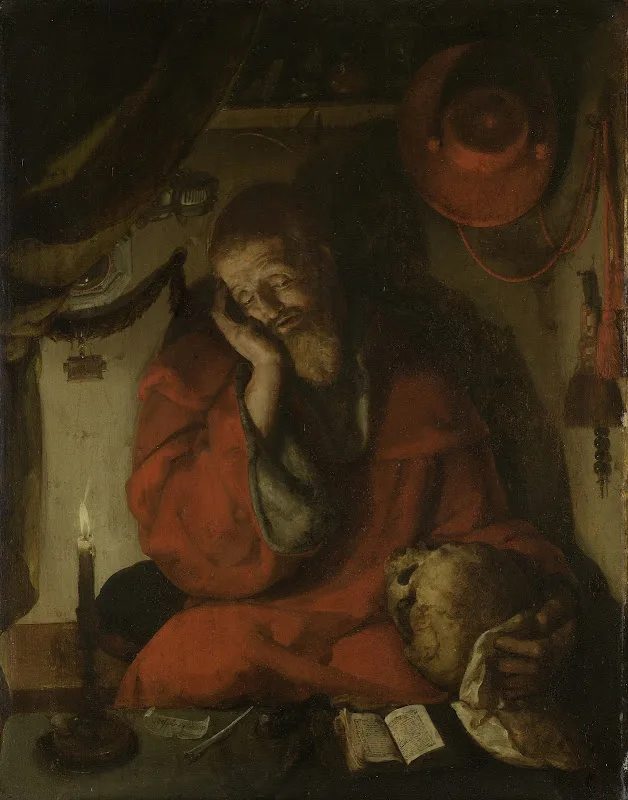
Van Leyden’s meticulous attention to detail and masterful use of light and shadow contribute to the evocative atmosphere of the painting. The soft, flickering light of the candle casts subtle shadows across St. Jerome’s face, enhancing the sense of depth and dimensionality. The rich, earthy tones of the background further emphasize the sense of warmth and intimacy, drawing viewers into the quiet sanctum of the saint’s study.
St. Jerome in His Study by Candlelight serves as a poignant reminder of the importance of scholarship, contemplation, and spiritual devotion. Through his sensitive portrayal of St. Jerome, van Leyden invites viewers to reflect on the enduring legacy of the scholar-saint and the timeless pursuit of knowledge and wisdom in the pursuit of spiritual enlightenment.

